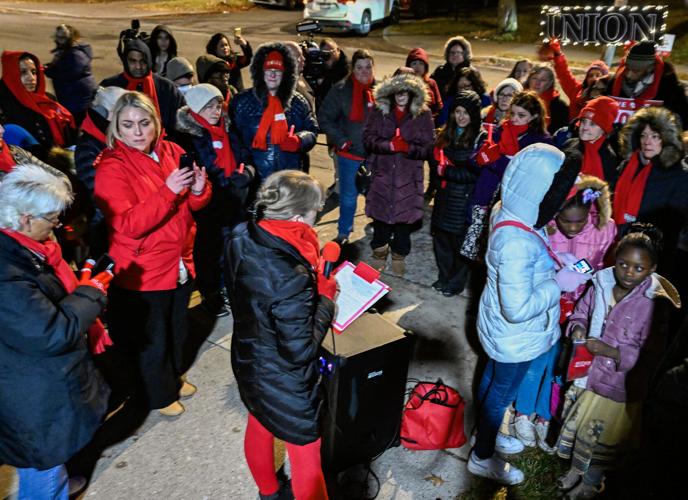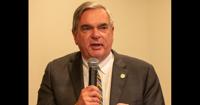WEIGHING IN - With the temperature hovering just above freezing, the more than 50 nurses and supporters huddled Wednesday night in front of Ellis Hospital were cold.
But, mostly, they were heated.
They were heated because of chronic understaffing inside the Schenectady hospital and at Bellevue Woman’s Center. It’s a situation so precarious that an analysis by the New York State Nurses Association found between February and November of this year that Ellis units have been understaffed an average of 93% of the time.
They were heated because nurses have been attempting to negotiate a contract with Ellis administrators since March to little avail. Their goal is a deal that would address the woeful staffing levels, which were supposed to have improved following the passage of last year’s state minimum staffing law.
Specific demands include a fair wage increase, the creation of an apprentice program, and adding to the number of nursing positions to ensure staff can have meal breaks.
But after 19 trips to the negotiating table, Ellis’ nurses say they haven’t made meaningful progress.
Ellis’ leaders contend that the hospital’s understaffing is part of a broader nursing shortage across the country.
But that argument gets the nurses heated, too.
The issue, nurses say, is not that there’s a scarcity of them. In fact, only 53% of licensed nurses in New York state are practicing, according to NYSNA, a union that represents more than 42,000 members. The issue is that the practicing nurses are stretched too thin, often forced to skip breaks and meals during 12-hour-plus shifts, leading to burnout and fewer people wanting to stay in the profession.
“The state is facing a shortage of good healthcare jobs, not healthcare workers themselves,” a NYSNA spokesperson said.
So the nurses are heated not just because of the difficult working conditions they routinely face. They are heated because those poor conditions lead to low staffing levels that put patients at risk.
Christine Walthers, a 60-year-old postpartum nurse and lactation specialist at Bellevue, has dealt firsthand with the short staffing – as a patient.
About six months ago, Walthers told me, she felt severe back pain during her shift, suspecting immediately it was another kidney stone. So after work, still wearing her Ellis badge, she went to the Ellis emergency room. After five hours, she was still waiting. People beside her said they’d been waiting nearly twice as long.
So she went home and suffered until she could call her urologist in the morning.
“It was a tough night,” said Walthers, who lives in Princetown. “I’m a member of this community. I came to the hospital that I work for, and I couldn't get seen.”
Sure, Ellis has since changed its ER intake policy to make the process more efficient, “but essentially what they’ve done is taken them from one waiting room and put them in another waiting room,” said ER Crisis Unit nurse Fred Durocher.
And Ellis’ understaffing is felt across its facilities, not just in the ER, according to NYSNA analysis.
For example, in one medical-surgical unit where nurses often see elderly patients, nurses have been asked to care for as many as seven patients. According to NYSNA, they aren’t supposed to be assigned more than four.
Ratio standards differ by units.
Another medical-surgical unit was understaffed 96% of the time, with nurse-to-patient ratios exceeding the safe staffing standard in 528 out of 551 shifts.
That is simply unacceptable.
During the pandemic, we heralded nurses – essential frontline workers – as heroes.
This is how Ellis treats them?
"Without you, there is no ‘care’ in health care,” NYSNA Executive Director Pat Kane told the crowd outside Ellis on Wednesday. “There is no ‘health’ either, quite honestly."
But Ellis seems not to have accepted that idea.
In response to NYSNA’s demonstrations, which nurses participated in during non-working hours, Ellis Medicine President and CEO Paul Milton said in a statement that Ellis has been listening.
“Ellis has been innovative in its approach to retaining and attracting nursing staff and providing them with an excellent place to work, a place where they are valued. We have worked closely with our affiliated nursing school and other educational institutions to build a sustainable pipeline of new nurses for the Ellis team,” Milton said. “Over the last 12 months, we have been able to gain real momentum and are moving in the right direction in creating that pipeline.”
In addition, Ellis’ president said staff are offered competitive salaries and benefit packages.
“Recently Ellis provided nurses with a very generous pay increase, increased bedside support staff, and implemented a comprehensive retention program across the hospital that has resulted in a better than market nurse retention rate and a reduction in overall turnover,” Milton said.
But if none of that can address short staffing, which could have serious consequences for patients, is it any wonder why NYSNA nurses had ample support Wednesday night, with elected officials from Schenectady City Council President Marion Porterfield to U.S. Rep. Paul Tonko coming out to speak in solidarity?
Not surprisingly, many of them were heated, too.
"Who suffers? The patients suffer. Our communities suffer,” said State Assemblyman Angelo Santabarbara. “We want good health care, quality health care. How can nurses do that if they are overloaded? How can they do that if they don't get the rest that they need to do their next shift? These are issues that affect all of us, all of our families.”
Of course, we know that Ellis has struggled financially.
But this summer, Ellis was handed a golden opportunity in the form of increased revenue through a changed Medicare reimbursement rule.
“It would move us probably over the next two years from a deficit situation to a positive situation. That’s how important this is,” Milton told me in April before the rule was finalized.
Shouldn’t a top priority then be investing this additional revenue in the staff who provide critical care?
Ellis is in the middle of a likely merger with St. Peter’s Health Partners, part of Trinity Health. Milton says the merger is needed to keep the hospital viable.
But that merger has a lot of people on edge, and not just because of how a deal with a Catholic-affiliated institution stands to curtail reproductive care. As negotiations with nurses continue to stall, there’s an open question about whether failing to sufficiently invest in nurses is financially motivated, and it’s fair to wonder what such a merger may mean for the kind of overall care Ellis will be committed to providing in the future.
“For 40 years, we have been merging hospitals, and while the costs have kept going up, the quality of care has gone down,” said State Assemblyman Phil Steck. “I highly question the viability of this merger. It's going to cannibalize this hospital from a standard-of-care perspective."
Steck believes Ellis’ only future may be as a public hospital, which would be funded by the state.
But such a drastic change is a long way off.
More pressing is what’s happening inside Ellis’ facilities right now.
Susan Williams, a Level 1 trauma nurse for 18 years, works at Ellis’ Medical Center of Clifton Park. She said she’s recently been on shifts at the emergent care center during which two nurses have been on when six nurses were needed.
The facility doesn’t turn anyone away, so being short staffed means working longer hours. Williams has recently worked shifts stretching 14 hours till 1 a.m. only to turn around and work another 12 hours the next day.
Even more alarming? Being short staffed can force some difficult choices.
“I don’t want to be the one who has to decide, ‘This person is having chest pain, that person is having shortness of breath because they are having a stroke — who am I going to see first?’” Williams said.
That’s a question that should leave us all heated.





















